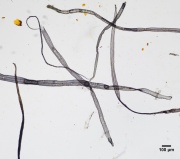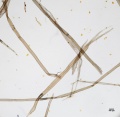Difference between revisions of "Kraft process"
JMcGlinchey (talk | contribs) (Created page with "== Description == A chemical method of producing paper pulp from wood using Sodium hydroxide and Sodium sulfide. This process is an improvement on the Soda process...") |
|||
| (15 intermediate revisions by 3 users not shown) | |||
| Line 1: | Line 1: | ||
| + | [[File:SUBK 10x2 label.jpg|thumb|Unbleached softwood kraft fibers stained with Graff "C" Stain]] | ||
== Description == | == Description == | ||
| − | A chemical method of producing paper pulp from wood using [[sodium hydroxide]] and [[sodium sulfide]]. This process is an improvement on the [[soda process]], which is closely related. The process has been used since 1890, but only gained popularity after an efficient recovery system was developed in 1930. | + | A chemical method of producing paper pulp from wood using [[sodium hydroxide]] and [[sodium sulfide]]. This process is an improvement on the [[soda process]], which is closely related. The process has been used since 1890, but only gained popularity after an efficient recovery system was developed in 1930. The kraft process is the most popular method for producing wood pulp in the US due to advantages over [[soda process|soda]] and [[sulfite process|sulfite]] pulping methods. Unlike the sulfite process, any wood species can be used. Additionally, cooking times are reduced, and waste recovery is more efficient. |
== Synonyms and Related Terms == | == Synonyms and Related Terms == | ||
| − | Sulfate pulp; kraft pulp; softwood bleached kraft; softwood kraft; hardwood bleached kraft; hardwood kraft | + | Sulfate pulp; kraft pulping; alkaline pulping; kraft pulp; softwood bleached kraft; softwood kraft; hardwood bleached kraft; hardwood kraft |
== Other Properties == | == Other Properties == | ||
| − | + | Kraft pulp tends to be stronger than other types of pulp, but actual strength varies by species. Due to higher levels of chromophors, kraft pulps tend to be darker than sulfite pulps. | |
| − | == | + | When stained with [[Graff "C" stain]], kraft pulp can appear in a range of colors depending on the wood type (softwood or hardwood) and the amount of bleaching. Unbleached kraft pulps will appear yellow or blue/grey. With increased bleaching, pulps will appear lighter and tend more toward red when treated with stain, though this can be difficult to see with hardwood pulps. The stained color of kraft pulp tends to be darker than [[sulfite process|sulfite]] pulp. |
| + | |||
| + | == Additional Images == | ||
| + | |||
| + | <gallery> | ||
| + | File:SUBK 40x label.jpg|Softwood kraft paper pulp stained with Graff "C" stain | ||
| + | File:Redoak vessels 10x.jpg|Hardwood kraft paper pulp stained with Graff "C" stain | ||
| + | Sycamore 10x2.jpg|Hardwood kraft paper pulp stained with Graff "C" stain | ||
| + | Ash 10x.jpg|Hardwood paper pulp stained with Graff "C" stain | ||
| + | UBK sugar pine 10x.jpg|Softwood kraft paper pulp stained with Graff "C" stain | ||
| + | </gallery> | ||
| + | |||
| + | ==Resources and Citations== | ||
* J.R.G. Bryce.“Sulfite Pulping” and “Alkaline Pulping”. ''Pulp and Paper: Chemistry and Chemical Technology, Volume 1, Edition 3.'' John Wiley & Sons, 1980. James P. Casey Ed. | * J.R.G. Bryce.“Sulfite Pulping” and “Alkaline Pulping”. ''Pulp and Paper: Chemistry and Chemical Technology, Volume 1, Edition 3.'' John Wiley & Sons, 1980. James P. Casey Ed. | ||
| + | * Christopher Biermann. ''Essentials of Pulping and Papermaking''. Academic Press, 1993. | ||
| + | * J. H. Graff "Color Atlas for Fiber Identification" The Institute of Paper Chemistry, Appleton, WI, 1940. | ||
| + | * Walter Rantanen. 'Fiber ID Course.' Integrated Paper Services. June 2013. Lecture. | ||
| + | *TAPPI Official Standard T401 om-08. ''Fiber analysis of paper and paperboard''. 2008. http://www.tappi.org/Downloads/Test-Methods/UNTITLED-0104T401pdf.aspx | ||
| − | + | [[Category:Materials database]][[Category:MWG]][[Category:Sheet, Cellulose]] | |
Revision as of 12:15, 2 October 2024
Description
A chemical method of producing paper pulp from wood using Sodium hydroxide and Sodium sulfide. This process is an improvement on the Soda process, which is closely related. The process has been used since 1890, but only gained popularity after an efficient recovery system was developed in 1930. The kraft process is the most popular method for producing wood pulp in the US due to advantages over soda and sulfite pulping methods. Unlike the sulfite process, any wood species can be used. Additionally, cooking times are reduced, and waste recovery is more efficient.
Synonyms and Related Terms
Sulfate pulp; kraft pulping; alkaline pulping; kraft pulp; softwood bleached kraft; softwood kraft; hardwood bleached kraft; hardwood kraft
Other Properties
Kraft pulp tends to be stronger than other types of pulp, but actual strength varies by species. Due to higher levels of chromophors, kraft pulps tend to be darker than sulfite pulps.
When stained with Graff "C" stain, kraft pulp can appear in a range of colors depending on the wood type (softwood or hardwood) and the amount of bleaching. Unbleached kraft pulps will appear yellow or blue/grey. With increased bleaching, pulps will appear lighter and tend more toward red when treated with stain, though this can be difficult to see with hardwood pulps. The stained color of kraft pulp tends to be darker than sulfite pulp.
Additional Images
Resources and Citations
- J.R.G. Bryce.“Sulfite Pulping” and “Alkaline Pulping”. Pulp and Paper: Chemistry and Chemical Technology, Volume 1, Edition 3. John Wiley & Sons, 1980. James P. Casey Ed.
- Christopher Biermann. Essentials of Pulping and Papermaking. Academic Press, 1993.
- J. H. Graff "Color Atlas for Fiber Identification" The Institute of Paper Chemistry, Appleton, WI, 1940.
- Walter Rantanen. 'Fiber ID Course.' Integrated Paper Services. June 2013. Lecture.
- TAPPI Official Standard T401 om-08. Fiber analysis of paper and paperboard. 2008. http://www.tappi.org/Downloads/Test-Methods/UNTITLED-0104T401pdf.aspx





